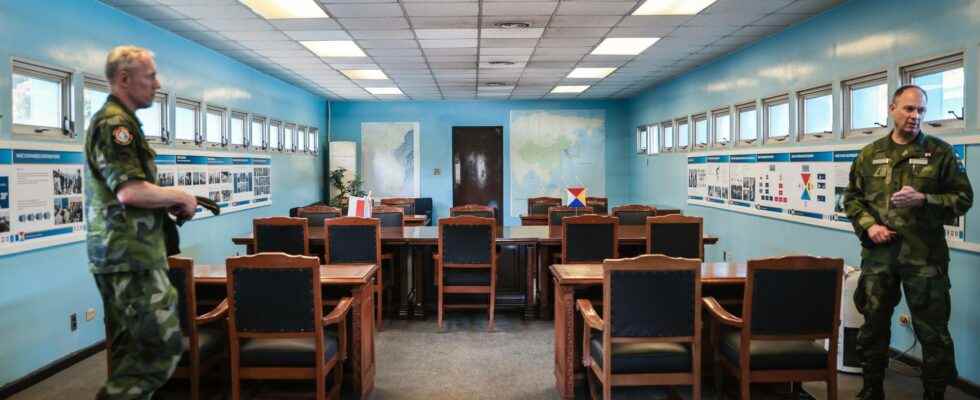1 of 8Photo: Simon Gate / TT
Not a movement can be discerned on the other side of the concrete threshold – the demarcation line – which runs straight through the three UN blue conference barracks.
– But we know that they are there, says the Swedish major Per Thulin and glances at the other side before he unlocks the door to the meeting room in the demilitarized zone between North and South Korea.
– Welcome to the last outpost of the Cold War, exclaims the Swedish major.
TT’s dispatcher has taken the subway from Seoul to the Munsan terminus. Mobile coverage dies when we are escorted into a landscape reminiscent of an idyll with farmland, forest, green mountains.
Per Thulin is one of five Swedish officers here on behalf of the Neutral Nations Monitoring Commission (NNSC). The group lives and works inside the village of Panmunjom – a unique place where both North and South Korea operate within the demilitarized zone, DMZ, whose name nevertheless runs along the world’s most fortified border. North of the border are one million soldiers ready, south are half a million.
We go under blast bridges, which in war explode and make impassability impossible. No, Per Thulin would not go on a run in the nature area.
– There are mines everywhere.
Heard the explosion
One Sunday recently, he was alone at the Swedish camp when he suddenly heard an explosion.
– It was not a small blow. I was ready to go down into the bunker. But since there was only one blow, I understood that it must have been a mine that was blown up. I wrote a report.
Twenty minutes and several checkpoints later, we turn onto NNSC, a showy area with dome-shaped houses that say T.
– T too temporary, explains Major General Anders Callert, Sweden’s head of delegation for NNSC.
The idea was that a peace agreement would be negotiated shortly after the armistice agreement in 1953. But soon seventy years have passed without a final agreement. The NNSC consists of five Swedes and five Swiss, whose task is to monitor compliance with the ceasefire agreement on the South Korean side.
– It is Sweden’s longest mission abroad, says Anders Callert, not without pride.
– We inspect that the joint military exercises of South Korea and the United States are of a defensive or deterrent nature and submit impartial reports. Our impartiality and transparency are much appreciated, but unfortunately it is only on the south side that NNSC operates today.
Occasional meetings
Initially, the NNSC had the same approach on the north side, where Czechoslovakia and Poland monitored that the North Korean side complied with the agreement. But after the partition of Czechoslovakia in 1993, the role in the NNSC ceased. A few years before Poland’s NATO membership in 1997, they were no longer allowed to operate in North Korea, and today the country only participates in occasional meetings within the NNSC, then on the south side.
An inevitable question is how compatible NNSC is with a Sweden in NATO. Is it possible to continue as a neutral supervisor?
– Yes absolutely. The neutral countries under the armistice agreement were those that did not take part in the war with combat units, which is not affected by NATO membership. It can be seen as Sweden lending out five officers who monitor that the ceasefire agreement is followed, says the major general, but adds later:
– The attitude of current NATO countries may change initially, but then they would probably realize that we are not here in the role of a NATO country, but that we will independently and impartially follow the ceasefire agreement.
A footbridge away is one of the most charged places in the world, which since the signing of the ceasefire agreement has been the scene of further negotiations between North and South. Presidents and heads of state visiting South Korea have frequently traveled here and been photographed while armed North and South Korean soldiers have come face to face.
The hope for a peace agreement and a nuclear settlement has never been greater than when North Korean leader Kim Jong-un and South Korean President Moon Jae-in 2018 stepped over the concrete threshold.
Three minute meeting
Then the iron curtain was quickly pulled down. It got icy cold again.
We enter the NNSC’s conference barracks, through the door on the South Korean side. An elongated conference table in the middle of the room shows the border between the countries. On the other side of the table is North Korea, with a door out into the closed country.
Every Tuesday at 10 am, the Swedish and Swiss NNSC delegation sits at this table and holds a formal meeting of three minutes.
– What a lot of symbolism, I thought at first, says Anders Callert.
– But it has a value. This shows that the ceasefire agreement is important. We are an impartial, credible observer. What we do is valuable, it creates stability.
If there is one thing the NNSC wants, it is for North Korea to once again accept the NNSC’s activities on its side, open the door and return to the meeting room. But the door to North Korea has been closed since 1995. The reports that the NNSC puts in North Korea’s mailbox after the weekly meeting are never retrieved.
On the way back to the Swedish camp, Anders Callert says with his eyes on the curtained windows on the north side of the concrete threshold:
– But we know that they know what applies.
